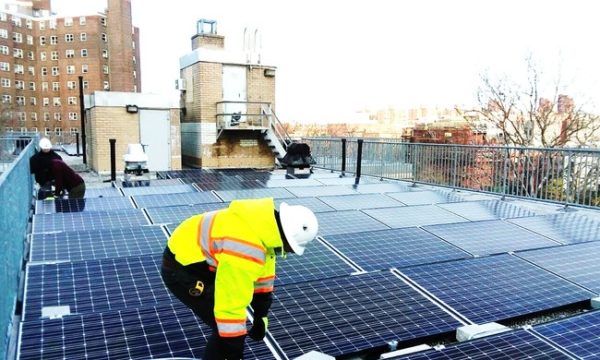Independent power producer Soltage and investment management firm Harrison Street formed a $250 million partnership to fund solar and other clean energy infrastructure assets developed by Soltage.
The two plan to deploy 450 MW of distributed solar and storage projects across the U.S. Assets will be owned by the partnership and operated by Soltage.
The first investment is a 14.5 MW portfolio of solar assets representing $30 million of project costs. The projects are expected to finalize construction and enter service this year, and include five sites in Maine, North Carolina, South Carolina, and Virginia. Power purchasers include utilities, corporates, and community solar off-takers.
Soltage has developed more than 100 solar energy projects with more than 400 MW total distributed generating capacity under construction and management. It is backed by investors including Prudential Capital Group. Harrison Street has roughly $32 billion in assets under management.
New York solar provides job training
Twelve newly trained solar installers who also live in New York City Housing Authority (NYCHA) developments are helping to deploy around 1 MW of rooftop solar on NYHCA buildings across the city.

Image: Accord Power
Con Edison’s Community Power program helps apprentice installers develop skills to work in the solar industry. The lead development partner, Solar One, provides training and education to make sustainable energy and green jobs more accessible.
Green City Force, WE ACT, and NYCHA recruited applicants for the apprenticeships. The apprentices work for Accord Power, a solar installer and certified Minority Business Enterprise. The rooftop solar effort is financed by Sunwealth.
At least 400 low- and moderate-income Con Edison customers will be able to sign up for electricity produced by the arrays. Annual bill savings are estimated to reach $120; revenue from the leased roof space will go to the host NYCHA developments.
Nevada transmission line
Nevada regulators approved the $2.5 billion Greenlink Nevada transmission and renewable energy initiative, which was proposed by utility NV Energy. The line is expected to enable development of around 5,000 MW of renewable energy projects across western and northern parts of the state.
NV Energy will start design and permitting work for two planned segments of Greenlink Nevada. Greenlink West, the first segment, is a single 525 kV line stretching about 370 miles northwest from Las Vegas to Yerington, and two 345 kV lines covering around 70 miles from Yerington north to the Reno/Sparks area. Greenlink West could enter service in December 2026.
Utility equipment sparked deadly fire
California fire officials determined that a deadly wildfire in September 2020 started when a pine tree came in contact with electric lines owned by utility Pacific Gas & Electric. The Zogg Fire burned more than 56,000 acres, killed four people, and left one person injured. It burned in Shasta County in far northern California.
An incident report that the utility filed with state regulators said that wildfire camera and satellite data on Sept. 27, 2020 showed smoke, heat, or signs of fire in an area served by a 12 kV PG&E-owned distribution line. According to utility records, a smart meter and line recloser serving the area reported alarms between 2:40 p.m. and 3:06 p.m., when the line recloser de-energized the circuit.
Record CO2 emissions prices
The most recent Regional Greenhouse Gas Initiative (RGGI) quarterly auction earlier in March resulted in a clearing price of $7.60 per short ton of carbon dioxide (CO2). That topped the previous high price of $7.50 per short ton reached in December 2015. States can reinvest proceeds from the auctions in programs to improve energy efficiency and speed deployment of renewable energy technologies.
The Energy Information Administration said the RGGI agreement was the first in the United States to place a cap on power sector CO2 emissions. Original RGGI member states are Connecticut, Delaware, Maine, Maryland, Massachusetts, New Hampshire, New Jersey, New York, Rhode Island, and Vermont. In January, Virginia became a full participant. New Jersey withdrew from the program in 2012 but rejoined in January 2020.
This content is protected by copyright and may not be reused. If you want to cooperate with us and would like to reuse some of our content, please contact: editors@pv-magazine.com.









By submitting this form you agree to pv magazine using your data for the purposes of publishing your comment.
Your personal data will only be disclosed or otherwise transmitted to third parties for the purposes of spam filtering or if this is necessary for technical maintenance of the website. Any other transfer to third parties will not take place unless this is justified on the basis of applicable data protection regulations or if pv magazine is legally obliged to do so.
You may revoke this consent at any time with effect for the future, in which case your personal data will be deleted immediately. Otherwise, your data will be deleted if pv magazine has processed your request or the purpose of data storage is fulfilled.
Further information on data privacy can be found in our Data Protection Policy.